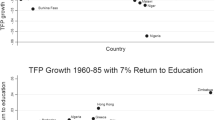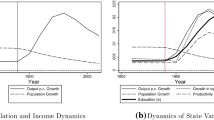Abstract
This paper asks whether the income gap between rich and poor nations can be explained by multiple equilibria. We explore the quantitative implications of a simple two-sector general equilibrium model that gives rise to multiplicity, and calibrate the model for 127 countries. Under the assumptions of the model, around a quarter of the world’s economies are found to be in a low output equilibrium. We also find that, since the output gains associated with an equilibrium switch are sizeable, the model can explain between 15 and 25% of the variation in the logarithm of GDP per worker across countries.
Similar content being viewed by others
References
D. Acemoglu F. Zilibotti (2001) ArticleTitleProductivity differences Quarterly Journal of Economics 116 IssueID2 563–606 Occurrence Handle10.1162/00335530151144104
W. Antweiler D. Trefler (2002) ArticleTitleIncreasing returns and all that: A view from trade American Economic Review 92 IssueID1 93–119
C. Azariadis (1996) ArticleTitleThe economics of poverty traps part one: Complete markets Journal of Economic Growth 1 IssueID4 449–486 Occurrence Handle10.1007/BF00150197
Azariadis, C. (2001). The theory of poverty traps: What have we learned? Manuscript, UCLA.
D.K. Backus P.J. Kehoe T.J. Kehoe (1992) ArticleTitleIn search of scale effects in trade and growth Journal of Economic Theory 58 IssueID3 377–409
A. Banerjee A.F. Newman (1998) ArticleTitleInformation, the dual economy, and development The Review of Economic Studies 65 IssueID4 631–653
S. Basu D.N. Weil (1998) ArticleTitleAppropriate technology and growth Quarterly Journal of Economics 113 IssueID4 1025–1054 Occurrence Handle10.1162/003355398555829
J. Benhabib R.E.A. Farmer (1996) ArticleTitleIndeterminacy and sector-specific externalities Journal of Monetary Economics 37 IssueID3 421–443 Occurrence Handle10.1016/0304-3932(96)01257-3
D.E. Bloom D. Canning J. Sevilla (2003) ArticleTitleGeography and poverty traps Journal of Economic Growth 8 IssueID4 355–378 Occurrence Handle10.1023/A:1026294316581
E.W. Bond R.W. Jones P. Wang (2005) ArticleTitleEconomic takeoffs in a dynamic process of globalization Review of International Economics 13 IssueID1 1–19 Occurrence Handle10.1111/j.1467-9396.2005.00489.x
C. Burnside (1996) ArticleTitleProduction function regressions, returns to scale, and externalities Journal of Monetary Economics 37 IssueID2 177–201 Occurrence Handle10.1016/S0304-3932(96)90033-1
R. Caballero R.K. Lyons (1992) The case for external economies Alex Cukierman (Eds) et al. Political economy, growth, and business cycles MIT Press Cambridge, MA
Caselli F. (2005). Accounting for cross-country income differences. forthcoming In Philippe Aghion and Steven Durlauf (Eds.), Handbook of economic growth. Amsterdam: North-Holland.
W.J. Coleman SuffixII F. Caselli (2001) ArticleTitleThe US structural transformation and regional convergence: A reinterpretation Journal of Political Economy 109 IssueID3 584–616
Caselli F., Coleman W.J., II. (2005). The world technology frontier. American Economic Review, forthcoming.
Chanda A., Dalgaard C.-J. (2005). Dual economies and international total factor productivity differences. Manuscript, University of Copenhagen, June.
J.-Y. Choi E.S.H. Yu (2003) External economies in the international trade theory: A survey E.K. Choi J. Harrigan (Eds) Handbook of international trade Blackwells Oxford
L.R. Christensen D. Cummings D.W. Jorgenson (1981) ArticleTitleEconomic growth, 1947–1973: An international comparison European Economic Review 16 IssueID1 61–94
S. Collins B. Bosworth (1996) ArticleTitleEconomic growth in East Asia: Accumulation versus assimilation Brookings Papers on Economic Activity 0 IssueID2 135–191
T.G. Conley W. Dupor (2003) ArticleTitleA spatial analysis of sectoral complementarity Journal of Political Economy 111 IssueID2 311–352 Occurrence Handle10.1086/367681
Cooper R.W. (2001). Estimation and identification of structural parameters in the presence of multiple equilibria. Manuscript, Boston University.
Duranton, G., & Jayet, H. (2005). Is the division of labour limited by the extent of the market? Evidence from French cities. CEPR discussion paper no. 5087.
Durlauf, S.,&Quah, D.T. (1999). The new empirics of economic growth. (J. B. Taylor,&M.Woodford (Eds.), Handbook of macroeconomics. Amsterdam: North-Holland.
W. Easterly (1994) ArticleTitleEconomic stagnation, fixed factors, and policy thresholds Journal of Monetary Economics 33 IssueID3 525–557 Occurrence Handle10.1016/0304-3932(94)90042-6
W.J. Ethier (1982a) ArticleTitleNational and international returns to scale in the modern theory of international trade American Economic Review 72 IssueID3 389–405
W.J. Ethier (1982b) ArticleTitleDecreasing costs in international trade and Frank Graham’s argument for protection Econometrica 50 IssueID5 1243–1268
S.J. Evenett W. Keller (2002) ArticleTitleOn theories explaining the success of the gravity equation Journal of Political Economy 110 IssueID2 281–31 Occurrence Handle10.1086/338746
R.E.A. Farmer (1999) The macroeconomics of self-fulfilling prophecies EditionNumber2 MIT Press Cambridge, MA
Feyrer J. (2003). Convergence by parts, Manuscript, Dartmouth College.
Food and Agricultural Organization. (1989). FAO Yearbook: Production. Rome: Food and Agricultural Organization.
M. Fujita P. Krugman A.J. Venables (1999) The spatial economy: Cities, regions, and international trade MIT Press Cambridge, MA
O. Galor (1996) ArticleTitleConvergence? Inferences from theoretical models Economic Journal 106 IssueID437 1056–1069
O. Galor D.N. Weil (2000) ArticleTitlePopulation, technology, and growth: From the Malthusian regime to the demographic transition and beyond American Economic Review 90 IssueID4 806–828
D. Gollin (2002) ArticleTitleGetting income shares right Journal of Political Economy 110 IssueID2 458–474 Occurrence Handle10.1086/338747
Graham B.S. (2000). Poverty traps and the world economy. M.Phil Thesis, Oxford University.
R.E. Hall C.I. Jones (1999) ArticleTitleWhy do some countries produce so much more output per worker than others? Quarterly Journal of Economics 114 IssueID1 84–116 Occurrence Handle10.1162/003355399555954
T.W. Hertel (1997) Global trade analysis: modelling and applications Cambridge University Press Cambridge
P. Howitt R.P. McAfee (1988) ArticleTitleStability of equilibria with externalities Quarterly Journal of Economics 103 IssueID2 261–277
C.I. Jones (1997) ArticleTitleOn the evolution of the world distribution of income Journal of Economic Perspectives 11 IssueID3 19–36
C. Karayalçın D. Mitra (1999) ArticleTitleMultiple equilibria, coordinationa and transitional growth Journal of Development Economics 60 297–316
M.C. Kemp A.G. Schweinberger (1991) ArticleTitleVariable returns to scale, non-uniqueness of equilibrium and the gains from international trade Review of Economic Studies 58 IssueID4 807–816
P.J. Klenow A. Rodríguez-Clare (1997) The neo-classical revival in growth economics: has it gone too far? B.S. Bernanke J.J. Rotemberg (Eds) NBER m acroeconomics annual 1997 The MIT Press Cambridge, MA 73–114
M. Kremer A. Onatski J. Stock (2001) ArticleTitleSearching for prosperity Carnegie-Rochester Conference Series on Public Policy 55 IssueID1 275–303 Occurrence Handle10.1016/S0167-2231(01)00060-4
P. Krugman (1991) ArticleTitleHistory versus expectations Quarterly Journal of Economics 106 IssueID2 651–667
P. Krugman (1995) Development, geography, and economic theory MIT Press Cambridge, MA
S. Kuznets (1966) Modern economic growth Yale University Press New Haven
T.R. Malthus (Eds) (1836) Principles of political economy: considered with a view to their practical application EditionNumber2 Augustus M. Kelley New York
N.G. Mankiw D. Romer D.N. Weil (1992) ArticleTitleA contribution to the empirics of economic growth Quarterly Journal of Economics 107 IssueID2 407–437
W. Martin D. Mitra (2001) ArticleTitleProductivity growth and convergence in agriculture and manufacturing Economic Development and Cultural Change 49 IssueID2 403–422 Occurrence Handle10.1086/452509
K. Matsuyama (1991) ArticleTitleIncreasing returns, industrialization and indeterminancy of equilibrium Quarterly Journal of Economics 106 IssueID2 617–650
K. Matsuyama (1992) ArticleTitleA simple model of sectoral adjustment Review of Economic Studies 59 IssueID2 375–387
Mitchell B.R. (1998a). International historical statistics — the Americas, 1750–1993. London: MacMillan Reference.
Mitchell B.R. (1998b). International historical statistics — Europe, 1750–1993. London: MacMillan Reference.
Mitchell B.R. (1998c). International historical statistics — Europe, 1750–1993. London: MacMillan Reference.
D. Mookherjee A.F. Shorrocks (1982) ArticleTitleA decomposition analysis of the trend in UK income inequality Economic Journal 92 IssueID368 886–902
Y. Murata (2002) ArticleTitleRural-urban interdependence and industrialization Journal of Development Economics 68 IssueID1 1–34 Occurrence Handle10.1016/S0304-3878(02)00004-4
K.M. Murphy A. Shleifer R.W. Vishny (1989) ArticleTitleIndustrialization and the big push Journal of Political Economy 97 IssueID5 1003–1020
G. Myrdal (1957) Economic theory and under-developed regions Duckworth London
R. Nurkse (1953) Problems of capital formation in underdeveloped countries Oxford University Press New York
A. Panagariya (1981) ArticleTitleVariable returns to scale in production and patterns of specialization American Economic Review 71 IssueID2 221–230
A. Panagariya (1988) ArticleTitleA theoretical explanation of some stylized facts of economic growth Quarterly Journal of Economics 103 IssueID3 509–526
E.C. Prescott (1998) ArticleTitleNeeded: A theory of total factor productivity International Economic Review 39 IssueID3 525–551
D. Quah (1993) ArticleTitleEmpirical cross-section dynamics in economic growth European Economic Review 37 IssueID2–3 426–434
D. Quah (1997) ArticleTitleEmpirics for growth and distribution: Stratification, polarization, and convergence clubs Journal of Economic Growth 2 IssueID1 27–59 Occurrence Handle10.1023/A:1009781613339
D. Quah (2001) ArticleTitleSearching for prosperity: A comment Carnegie-Rochester Conference Series on Public Policy 55 IssueID1 305–319 Occurrence Handle10.1016/S0167-2231(01)00061-6
D. Ray (2000) ArticleTitleWhat’s new in development economics? The American Economist 44 IssueID2 3–16
D. Rodrik (1995) ArticleTitleGetting interventions right: How South Korea and Taiwan grew rich Economic Policy 0 IssueID20 53–97
D. Rodrik (1996) ArticleTitleCoordination failure and government policy: A model with applications to East Asia and Eastern Europe Journal of International Economics 40 IssueID1–2 1–22
P. Romer (1986) ArticleTitleIncreasing returns and long-run growth Journal of Political Economy 94 IssueID5 1002–1037
Rose A.K. (2005). Size really doesn’t matter: In search of a national scale effect. CEPR discussion paper no. 5350.
P.N. Rosenstein-Rodan (1943) ArticleTitleProblems with industrialization of Eastern and South-eastern Europe Economic Journal 53 IssueID210/211 202–211
Rosenthal S.S., Strange W. (2004). Evidence on the nature and sources of agglomeration economies, In Vernon Henderson and Jacques-Francois Thisse (Eds.), Handbook of regional and urban economics, vol. 4. Amsterdam: North Holland pp. 2119–2171.
E. Rossi-Hansberg (2005) ArticleTitleA spatial theory of trade American Economic Review 95 IssueID5 1464–1491
Rossi-Hansberg E., Wright M.L.J. (2005). Urban structure and growth. NBER working paper no. 11262.
S.J. Sheather M.C. Jones (1991) ArticleTitleA reliable data-based bandwidth selection method for kernel density estimation Journal of the Royal Statistical Society B 53 IssueID3 683–690
A.F. Shorrocks (1980) ArticleTitleThe class of additively decomposable inequality measures Econometrica 48 IssueID3 613–625
Temple J.R.W., Woessmann L. (2004). Dualism and cross-country growth regressions. CESifo working paper no. 1290.
J.R.W. Temple (2005) ArticleTitleDual economy models: A primer for growth economists The Manchester School 73 IssueID4 435–478 Occurrence Handle10.1111/j.1467-9957.2005.00454.x
Ulubasoglu M., Cardak B. (2005). International comparison of rural-urban educational attainment: Data and determinants. Deakin University, School of Accounting, Economics and Finance working paper no. 2005/01.
InstitutionalAuthorNameUnited Nations, Statistical Office (1980) Yearbook of national accounts statistics United Nations New York
InstitutionalAuthorNameUnited Nations (1991) National accounts statistics: Main aggregates and detailed tables United Nations New York
InstitutionalAuthorNameUnited Nations (1994) National accounts statistics: Main aggregates and detailed tables United Nations New York
InstitutionalAuthorNameUnited Nations (1995) National accounts statistics: Main aggregates and detailed tables United Nations New York
InstitutionalAuthorNameUnited Nations, Statistical Division (1999) Statistical yearbook CD-ROM United Nations New York
InstitutionalAuthorNameWorld Bank (2000) World development indicators 2000 CD-ROM The World Bank Washington D.C.
Author information
Authors and Affiliations
Rights and permissions
About this article
Cite this article
Graham, B.S., Temple, J.R.W. Rich Nations, Poor Nations: How Much Can Multiple Equilibria Explain?. J Econ Growth 11, 5–41 (2006). https://doi.org/10.1007/s10887-006-7404-5
Issue Date:
DOI: https://doi.org/10.1007/s10887-006-7404-5




